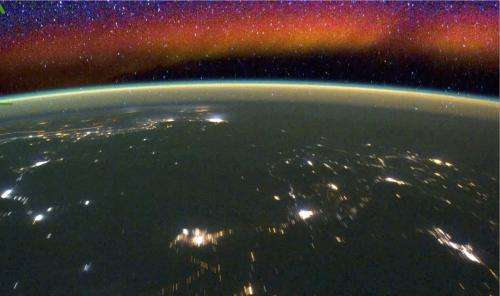ICON cleared for next development phase

NASA has officially confirmed the Ionospheric Connection Explorer, or ICON, mission, clearing it to move forward into the development phase. ICON will explore a swath of Earth's atmosphere where weather close to the ground impacts the dynamic space environment above in unexpected ways.
By studying this area where terrestrial weather meets space weather, ICON will help resolve long-standing mysteries about the behavior of our planet's upper atmosphere, including what causes disruptions in this region, such as those that can significantly affect radio transmissions.
"ICON addresses a national need to predict these kinds of disturbed conditions in space," said Thomas Immel, principal investigator for ICON at the University of California at Berkeley. "These disturbances can cause radio communication to suddenly and unexpectedly drop out, which is a problem for ships, airplanes, the global positioning system, and the military."
To study the connection between these space weather disturbances and Earth's weather, ICON will measure how motions in the lower atmosphere are transmitted into space. The lowest layer of the atmosphere—the one we live in and where we experience weather—is the troposphere. Above that is the stratosphere, the mesosphere, and the thermosphere. All of these are layers of the atmosphere made of neutral gas, which can move in reaction to the weather down closest to Earth.
The neutral particles in the mesosphere and higher up, however, exist side-by-side with a giant layer of charged particles stretching from 60 to 600 miles high, called the ionosphere. The charged particles are pushed around by the neutral gas, but are also pushed by electric and magnetic fields that course through the region. These forces are at work throughout the ionosphere, day and night.
ICON will fly at a height of some 360 miles and aim its instruments for a view of what's happening at the lowest reaches of space up to 250 miles – providing the first ever comprehensive measurements of the region where the thermosphere and ionosphere overlap. Exploring this region will open up entirely new avenues of exploration, because traditionally the ionospheric disturbances at low latitudes were assumed to be primarily driven by the sun.
"For years people thought that energy coming in from above, through the solar wind or solar ultraviolet radiation, was the only cause of changes in the upper atmosphere," said Doug Rowland, mission scientist for ICON at NASA's Goddard Space Flight Center in Greenbelt, Maryland. "But we now realize that atmospheric movements down below, closer to Earth, actually have a strong effect on what's happening above."
For example, recent images of the ionosphere in ultraviolet light have shown bright spots in two bands around the middle of Earth—the brightness represents areas where the charged gas density is significantly higher. The spots also change over time in sync with daily cycles within the lower atmosphere, suggesting that they are directly linked to Earth's weather.
"Since 2000, we have seen more, very clear evidence that our previous theories about a solar-driven ionosphere does not match reality," said Immel. "Instead, the structure of the ionosphere changes with weather and with the seasons. There must be another driver of these disturbances besides the sun, and whatever it is, it's large and controlling."
ICON will fly with four instruments. The Michelson Interferometer for Global High-Resolution Thermospheric Imaging, or MIGHTI, will observe the temperature and speed of the neutral particles. The Ion Velocity Meter will observe the speed of the charged particle motions, which may be very different from the neutral gas. Measurements of the particle density and composition are made by two spectrographic imagers: one gathering extreme ultraviolet light, the other gathering far ultraviolet light. These will be able to spot light emitted or scattered from particles in the thermosphere and ionosphere, which can then be translated into understanding just how many neutral and ionized particles are present, as well as what types of particles are predominant under different conditions.
Together, the instruments will provide the first comprehensive look at this crucial region to help scientists understand – and some day predict – what drives disturbances in the ionosphere.
Now that NASA has confirmed ICON, the next step is the critical design review in 2015. This would clear the mission to build the necessary flight hardware for launch. The launch is planned for no later than October 2017.
ICON is an Explorer-class mission. NASA's Goddard Space Flight Center in Greenbelt, Maryland, manages the Explorer Program for NASA's Science Mission Directorate in Washington. UC Berkeley's Space Sciences Laboratory will develop the ICON mission and the two ultraviolet imaging spectrographs. The Naval Research Laboratory in Washington, D.C will develop the MIGHTI instrument. The University of Texas in Dallas will develop the Ion Velocity Meter. The spacecraft is being built by Orbital Sciences Corporation in Dulles, Virginia.
More information: For more information on ICON: www.nasa.gov/home/hqnews/2013/ … Helio_Explorers.html
Provided by NASA





















